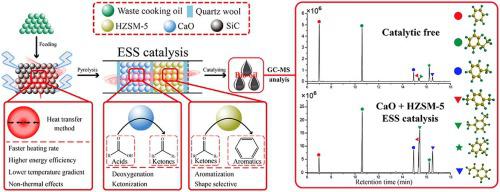当前位置:
X-MOL 学术
›
Energy Convers. Manag.
›
论文详情
Our official English website, www.x-mol.net, welcomes your
feedback! (Note: you will need to create a separate account there.)
Microwave-assisted pyrolysis of waste cooking oil for hydrocarbon bio-oil over metal oxides and HZSM-5 catalysts
Energy Conversion and Management ( IF 9.9 ) Pub Date : 2020-09-01 , DOI: 10.1016/j.enconman.2020.113124 Qiuhao Wu , Yunpu Wang , Yujie Peng , Linyao Ke , Qi Yang , Lin Jiang , Leilei Dai , Yuhuan Liu , Roger Ruan , Donghua Xia , Li Jiang
Energy Conversion and Management ( IF 9.9 ) Pub Date : 2020-09-01 , DOI: 10.1016/j.enconman.2020.113124 Qiuhao Wu , Yunpu Wang , Yujie Peng , Linyao Ke , Qi Yang , Lin Jiang , Leilei Dai , Yuhuan Liu , Roger Ruan , Donghua Xia , Li Jiang

|
Abstract Microwave-assisted pyrolysis of waste cooking oil is an environmentally friendly and economical method for obtaining benzene, toluene, ethylbenzene, and xylene (BTEX) which are important industrial chemicals. This study provides new routes to produce of BTEX and the utilization of waste cooking oil. The effect of catalytic temperatures (350 °C, 400 °C, 450 °C, 500 °C, and 550 °C), types of metal oxide (CoO, NiO, ZrO2, SrO, CeO2, and CaO), catalytic modes (ex-situ mixed catalysis, ex-situ separate catalysis, and in-situ separate catalysis), and ratio of HZSM-5 to metal oxide (HZSM-5 only, 4:1, 2:1, 1:1, 1:2, and CaO only) were studied. Results showed high catalytic temperature promoted the formation of monocyclic aromatic hydrocarbons at the cost of a decrease in bio-oil yield. But the concentration of BTEXS (benzene, toluene, ethylbenzene, xylene, and styrene) only increased from 256.58 mg/ml to 259.55 mg/ml with a temperature increase from 500 °C to 550 °C. Alkaline earth metal oxides (CaO, SrO) showed a significant deoxygenation capability during co-catalysis with HZSM-5. However, when CaO was applied under ex-situ mixed catalysis, the concentration of polycyclic aromatic hydrocarbons was up to 35.47%, which was much higher than 9.18% under HZSM-5 only. Also, the concentration of BTEXS decreased from 256.58 mg/ml (HZSM-5 only) to 167.54 mg/ml (HZSM-5 mixed with CaO). Further investigation of catalytic mode showed that ex-situ separate catalysis was more suitable for co-catalysis of alkaline earth metal oxides and HZSM-5. The concentration of BTEXS were both significantly higher than that of HZSM-5 only, which increased by 121.81 mg/ml for CaO and 108.52 mg/ml for SrO under ex-situ separate catalysis. Further study showed that the highest concentration of BTEXS was 702.20 mg/ml obtained when the ratio of HZSM-5 to CaO was 2:1. It was almost 2.8 times higher than HZSM-5 alone and 42.2 times higher than non-catalytic results.
中文翻译:

在金属氧化物和 HZSM-5 催化剂上微波辅助热解废食用油制备烃类生物油
摘要 废食用油微波辅助热解是一种环保、经济的制取苯、甲苯、乙苯和二甲苯(BTEX)的重要工业化学品的方法。该研究为BTEX的生产和废弃食用油的利用提供了新的途径。催化温度(350 °C、400 °C、450 °C、500 °C 和 550 °C)、金属氧化物类型(CoO、NiO、ZrO2、SrO、CeO2 和 CaO)、催化模式(异位混合催化、异位分离催化和原位分离催化),以及 HZSM-5 与金属氧化物的比例(仅 HZSM-5,4:1、2:1、1:1、1:2 ,和仅 CaO) 进行了研究。结果表明,高催化温度以降低生物油产量为代价促进了单环芳烃的形成。但 BTEXS(苯、甲苯、乙苯、随着温度从 500 °C 增加到 550 °C,二甲苯和苯乙烯)仅从 256.58 mg/ml 增加到 259.55 mg/ml。碱土金属氧化物(CaO、SrO)在与 HZSM-5 的共催化过程中表现出显着的脱氧能力。然而,当 CaO 在异位混合催化下应用时,多环芳烃的浓度高达 35.47%,远高于仅在 HZSM-5 下的 9.18%。此外,BTEXS 的浓度从 256.58 mg/ml(仅 HZSM-5)降至 167.54 mg/ml(HZSM-5 与 CaO 混合)。进一步研究催化模式表明,异位分离催化更适合碱土金属氧化物和HZSM-5的共催化。BTEXS 的浓度均显着高于仅 HZSM-5 的浓度,CaO 和 108 增加了 121.81 mg/ml。在异位单独催化下,SrO 为 52 mg/ml。进一步研究表明,当 HZSM-5 与 CaO 的比例为 2:1 时,BTEXS 的最高浓度为 702.20 mg/ml。它几乎比单独的 HZSM-5 高 2.8 倍,比非催化结果高 42.2 倍。
更新日期:2020-09-01
中文翻译:

在金属氧化物和 HZSM-5 催化剂上微波辅助热解废食用油制备烃类生物油
摘要 废食用油微波辅助热解是一种环保、经济的制取苯、甲苯、乙苯和二甲苯(BTEX)的重要工业化学品的方法。该研究为BTEX的生产和废弃食用油的利用提供了新的途径。催化温度(350 °C、400 °C、450 °C、500 °C 和 550 °C)、金属氧化物类型(CoO、NiO、ZrO2、SrO、CeO2 和 CaO)、催化模式(异位混合催化、异位分离催化和原位分离催化),以及 HZSM-5 与金属氧化物的比例(仅 HZSM-5,4:1、2:1、1:1、1:2 ,和仅 CaO) 进行了研究。结果表明,高催化温度以降低生物油产量为代价促进了单环芳烃的形成。但 BTEXS(苯、甲苯、乙苯、随着温度从 500 °C 增加到 550 °C,二甲苯和苯乙烯)仅从 256.58 mg/ml 增加到 259.55 mg/ml。碱土金属氧化物(CaO、SrO)在与 HZSM-5 的共催化过程中表现出显着的脱氧能力。然而,当 CaO 在异位混合催化下应用时,多环芳烃的浓度高达 35.47%,远高于仅在 HZSM-5 下的 9.18%。此外,BTEXS 的浓度从 256.58 mg/ml(仅 HZSM-5)降至 167.54 mg/ml(HZSM-5 与 CaO 混合)。进一步研究催化模式表明,异位分离催化更适合碱土金属氧化物和HZSM-5的共催化。BTEXS 的浓度均显着高于仅 HZSM-5 的浓度,CaO 和 108 增加了 121.81 mg/ml。在异位单独催化下,SrO 为 52 mg/ml。进一步研究表明,当 HZSM-5 与 CaO 的比例为 2:1 时,BTEXS 的最高浓度为 702.20 mg/ml。它几乎比单独的 HZSM-5 高 2.8 倍,比非催化结果高 42.2 倍。











































 京公网安备 11010802027423号
京公网安备 11010802027423号